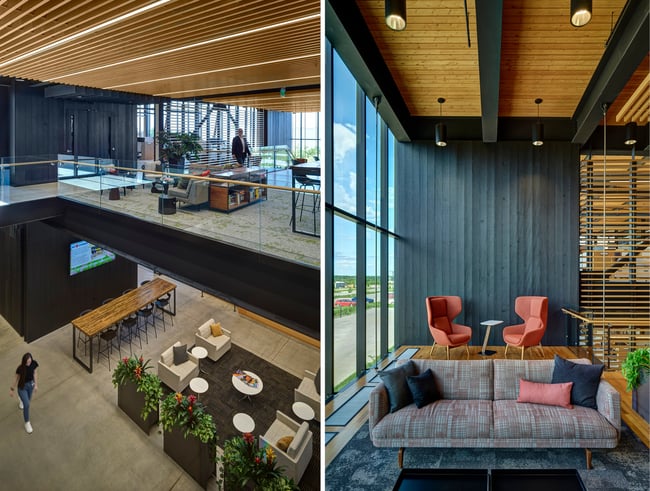Workplace Design: Pros and Cons of Hot Desking

With the rise of hybrid work, many organizations are looking for new approaches to workplace design. Traditional office layouts are giving way to more flexible environments that promote collaboration and interaction.
One popular approach is hot desking, a system where workers do not have assigned desks. Workstations are open to anyone, and workers can move to different locations throughout the day.
We’ve guided many organizations through workplace design projects and have helped them determine if hot desking fits their needs. In our experience, the approach offers many benefits but may not fit every worker or organizational culture.
To help you determine if hot desking works for your workplace, this article will discuss the pros and cons of this approach and alternative solutions.
Pros of Hot Desking
1. Reduced Real Estate
The most obvious benefit of hot desking is reduced office space. Organizations can reduce their square footage with fewer workstations, making the approach popular in highly competitive real estate markets.
Beyond these markets, hot desking works well for organizations adopting a hybrid work model. Assigned seats can feel redundant and unnecessary when a portion of the office works remotely. With hot desking, you can size your office to fit the number of workers on-site at any given time.
Reduced desk numbers also allow for a greater range of spaces—from collaborative areas to enclosed focus rooms. Without assigned desks, workers have the choice to move about the office and find a space that suits the tasks they need to complete.

Fewer workstations allows for a greater range of communal spaces.
2. Reduced Clutter
Clutter is a common problem in many workplaces. With assigned desks, workers are likely to accumulate office supplies, unnecessary papers, and personal belongings over time.
With hot desking, workers are expected to clear their desk at the end of the day, so it is available for the next person. Workplaces can also assign individual lockers for storing personal belongings.
The approach encourages people to be more intentional about what they store, print, and bring to the office. It can also lead to more frequent cleaning. With workers moving locations, surfaces are cleaned and disinfected more often.
3. Improved Collaboration and Mentorship
Traditional assigned seating can limit interaction and collaboration. Hot desking allows people to move around the office and sit by different people, strengthening your organizational culture.
With this approach, seating becomes more intentional, with workers finding a location that best suits their needs. One day, they may sit by a teammate to meet a project deadline. Another day, they may find a quiet area to focus. In short, workers have more control over their day, making time at the office more productive.
At the same time, hotdesking can improve mentorship. Newer, younger workers have the chance to sit by different coworkers, build connections, and learn on the job. They are more likely to get involved in conversations and feel more connected to your organization.
Cons of Hot Desking
1. May Not Fit Every Worker
Although hot desking offers many benefits, it may not fit everyone’s approach to work. Some people may work better with an assigned desk, especially if they are in the office daily.
At the same time, it can create an intimidating environment for some new hires. According to a study from Steelcase, Gen Z workers are more willing to work in the office than older generations. However, they prefer an assigned desk.
Having an assigned desk can provide structure and a sense of familiarity. As workers get used to your company and culture, it may help to give them a designated workstation.
2. Less Personal
While hot desking can reduce clutter, it can feel less personal. With assigned desks, workers are likely to decorate, display pictures, and show off their personality.
Personal objects can make people more comfortable in the office and can act as a great icebreaker between teammates. With hot desking, you risk losing the “home-like” environment some may desire.
3. Increased Technology Costs
Although hot desking can save on real estate costs, some organizations may need to upgrade technology.
Often, hot desking requires workers to have laptops, with docking stations at each desk. Technology should be consistent across the office, so workers can seamlessly move from one location to another.
For some organizations, these investments can be significant, especially on a building project with other costs to consider.
Alternative Solution: Finding a Middle Ground
While some organizations may fully embrace hot desking, others may want to find a middle-ground. Moving desks may work well for some workers, but others may be more productive and comfortable with a consistent location.
An alternative approach is to disperse assigned workstations throughout the hot desking area. Some workers will maintain a consistent location while those around them change from day-to-day.
People with assigned seats benefit from increased interaction and variety without sacrificing consistency. New hires can get to know their coworkers and receive mentorship without the awkwardness of finding a different seat each day.
When taking this approach, ensure workers with assigned desks have access to the same technology as those who are hot desking. Everyone should be able to move around the office and work in an area that best fits their needs, with technology integrated seamlessly into every location.
Learn More About Workplace Design
In the post-pandemic workplace, hotdesking offers many benefits. It can help maximize limited square footage, right-size the office for a hybrid workforce, and encourage collaboration and flexibility.
However, organizations should consider their employees and culture before adopting this approach. Engaging your team and discussing their needs will lead to solutions that best fit their approach to work.
On a building project, it’s also important to consider your operations, growth projections, and how you will guide your team through change. Learn more by reading about the factors to consider before starting a workplace design project.